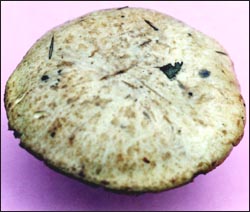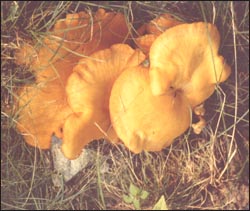식중독으로 생기는 설사(1) Diarrhea caused by food poisoning-part

사진 58. 독버섯 중독으로 설사할 수 있다.
Copyright ⓒ 2011 John Sangwon Lee, MD., FAAP

사진 59. 독버섯 식중독으로도 설사할 수 있다.
Copyright ⓒ 2011 John Sangwon Lee, MD., FAAP
- 보통 먹는 음식물, 인공영양, 이유식, 또는 가공 음식물 등을 제조, 운반, 재 조리하는 과정에서 독성 유기물질, 독성 무기물질, 또는 독성 화학물질 등이 오염되거나, 박테리아, 바이러스, 곰팡이(진균), 또는 기생충 등 병원체에 오염되거나 세균 균독 등에 오염될 수 있다. 이런 오염된 음식물을 먹을 때 식중독에 걸릴 수 있고 그로 인해 설사 할 수 있다.
- 음식물 식중독을 일으킬 수 있는 병원체는 박테리아, 바이러스, 곰팡이(진균), 기생충 등이 있다. 그 병원체들 중 식중독을 일으킬 수 있는 병원체들의 이름을 열거하면 다음과 같다
① Bacillus cereus,
② Campylobacter jejuni,
③ Clostridium botulinum,
④ Clostridium perfringens,
⑤ Cryptosporidium parvum,
⑥ Escherichia Coli 0157:H7,
⑦ Giardia lamblia,
⑧ Hepatitis A Virus (HAV),
⑨ Listeria monocytogenes,
⑩ Norovirus or Norwalk Virus,
⑪ Salmonella,
⑫ Staphylococcus aureus,
⑬ Shigella,
⑭ Toxoplasma gondii,
⑮ Vibrio,
⑯ Yersinia enterocolitica
⑰ 그 외
- 이상 열거한 여러 종류의 병원체들 중 한 종류나 여러 종류의 병원체에 오염되거나 병원체에서 나온 세균 균독에 오염된 음식물을 먹을 때 설사를 할 수 있다. 그런 설사의 원인을 식품 원인이라고 한다. 식품 원인으로 생긴 식중독을 식품원인 식중독이라 한다. 그런 식품원인 식중독으로 설사를 할 수 있다.
- 파라티온, 말라티온, 또는 그 외 다른 종류의 살충제에 오염된 음식물을 먹거나, 그런 살충제를 잘못 취급해서 호흡기 속으로 직접 흡인하거나, 경구로 마시거나, 독성 물질이 피부를 통해서 체내로 흡인될 때도 식중독 될 수 있고, 그로 인해 설사를 할 수 있다.
- 빈혈을 치료하기 위해 철분제를 경구로 섭취했을 때 위장관이 철분제로 자극되어 설사를 할 수 있다.
- 각종 약물로 치료할 때도 약물 부작용으로 설사를 할 수 있다.
- 독성 동식물 음식물을 먹고 식중독에 걸릴 수 있고 그로 인해 설사를 할 수 있다. [부모도 반의사가 되어야 한다-소아가정간호백과]-제1권 소아청소년 응급의료-동․식물 중독 참조.
- 그 외, 음식물 색소용 화학 물질, 음식물 방부제용 화학 물질, 음식물 감미용 화학 물질 등으로 설사를 할 수 있다.
Diarrhea caused by food poisoning-part 식중독으로 생기는 설사

Picture 58. Poisoning mushrooms can cause diarrhea. Copyright ⓒ 2011 John Sangwon Lee, MD., FAAP

Photo 59. Poisonous mushroom food poisoning can also cause diarrhea. Copyright ⓒ 2011 John Sangwon Lee, MD., FAAP
• In the process of manufacturing, transporting, and re-cooking food, artificial nutrition, baby food, or processed food, etc., toxic organic substances, toxic inorganic substances, or toxic chemical substances are contaminated, bacteria, viruses, molds (fungi), etc.
Or it may be contaminated with pathogens such as parasites or contaminated with bacterial toxins.
Eating these contaminated foods can lead to food poisoning, which can lead to diarrhea.
• Food pathogens that can cause food poisoning include bacteria, viruses, fungi (fungi), and parasites.
Among the pathogens, the names of pathogens that can cause food poisoning are listed below.
① Bacillus cereus,
② Campylobacter jejuni,
③ Clostridium botulinum,
④ Clostridium perfringens,
⑤ Cryptosporidium parvum,
⑥ Escherichia Coli 0157:H7,
⑦ Giardia lamblia,
⑧ Hepatitis A Virus (HAV),
⑨ Listeria monocytogenes, ⑩ Norovirus or Norwalk Virus, ⑪ Salmonella, ⑫ Staphylococcus aureus,
⑬ Shigella,
⑭ Toxoplasma gondii,
⑮ Vibrio,
⑯ Yersinia enterocolitica
⑰ others
• You may have diarrhea when you eat food contaminated with one of the many types of pathogens listed above, or foods contaminated with bacterial toxins from pathogens. The cause of such diarrhea is called food causes. Food poisoning caused by food is called food poisoning, which is a food source. Food poisoning, which is such a food source, can cause diarrhea.
• Food poisoning when eating food contaminated with parathion, malathion, or other types of insecticides, or when the insecticide is mishandled and aspirated directly into the respiratory tract, or when a toxic substance is aspirated into the body through the skin. It can be, and it can lead to diarrhea.
• When iron drugs are taken orally to treat anemia, the gastrointestinal tract may be irritated with iron and diarrhea.
• Even when treated with various drugs, diarrhea may occur as a side effect of drugs.
• Eating toxic animal and plant foods can lead to food poisoning, resulting in diarrhea. [Parents should also be www.drleepediatrics.com-Vol. 1 Children and Adolescent Emergency Medical Services-Refer to Animal and Plant Poisoning.
• In addition, diarrhea can be caused by chemicals for food coloring, chemicals for food preservatives, and chemicals for sweetening foods.
출처 및 참조 문헌 Sources and references
- NelsonTextbook of Pediatrics 22ND Ed
- The Harriet Lane Handbook 22ND Ed
- Growth and development of the children
- Red Book 32nd Ed 2021-2024
- Neonatal Resuscitation, American Academy Pediatrics
- www.drleepediatrics.com제7권 소아청소년 감염병
- www.drleepediatrics.com제9권 소아청소년 소화기 질환
- Red book 29th-31st edition 2021
- Nelson Text Book of Pediatrics 19th — 21st Edition
- The Johns Hopkins Hospital, The Harriet Lane Handbook, 22nd edition
-
Childhood Emergencies in the Office, Hospital and Community, American Academy of Pediatrics
-
Emergency Medical Service for Children, By Ross Lab. May 1989. p.10
-
Emergency care, Harvey grant, and Robert Murray
-
Emergency Care Transportation of Sick and Injured American Academy of Orthopaedic Surgeons
-
Emergency Pediatrics A Guide to Ambulatory Care, Roger M. Barkin, Peter Rosen
-
Immediate care of the acutely ill and injured, Hugh E. Stephenson, Jr
-
The Critically Ill Child, Diagnosis and Management, Edited by Clement A. Smith
-
Emergency Medical Services for Children: The Role of the Primary Care Provider, America Academy of Pediatrics
-
Quick Reference To Pediatric Emergencies, Delmer J. Pascoe, M.D., Moses Grossman, M.D. with 26 contributors
-
Manual of Emergency Care
-
응급환자관리 정담미디어
-
소아가정간호백과–부모도 반의사가 되어야 한다, 이상원
-
Neonatal Resuscitation American heart Association
-
Neonatology Jeffrey J.Pomerance, C. Joan Richardson
-
Pediatric Resuscitation Pediatric Clinics of North America, Stephen M. Schexnayder, M.D.
-
Pediatric Critical Care, Pediatric Clinics of North America, James P. Orlowski, M.D.
-
Preparation for Birth. Beverly Savage and Dianna Smith
- Infectious disease of children, Saul Krugman, Samuel L Katz, Ann A. Gershon, Catherine Wilfert
-
The Harriet Lane Handbook 19th Edition
-
소아과학 대한교과서
-
제1권 소아청소년 응급의료 참조문헌과 출처
-
Other
다음은 『식중독으로 생기는 설사 (2)』로 이어짐
Copyright ⓒ 2015 John Sangwon Lee, MD., FAAP
“부모도 반의사가 되어야 한다”-내용은 여러분들의 의사로부터 얻은 정보와 진료를 대신할 수 없습니다.
“The information contained in this publication should not be used as a substitute for the medical care and advice of your doctor. There may be variations in treatment that your doctor may recommend based on individual facts and circumstances. “Parental education is the best medicine.”